First post, by Mamba
- Rank
- Oldbie
Hello,
I acquired an apparently broken P5A-B.
It powers on but the screen stays black.
Cpu and chipsets both get warm, there is power on agp and pci for sure as well.
Caps look good also.
So I am trying to hotflash it.
Problem is that apparently I can’t.
The chip is an ATMEL AT29c010A so using -FORCE parameter should do the trick.
Not in this case as I get DATA VERIFICATION ERROR (see image).
Any fast suggestion?
The bios chip is definitely correct and so the hex used (1FD5).
I am using my old GA-586DX to hotflash, different chipset but is an hotflash procedure, should not be relevant, right?

